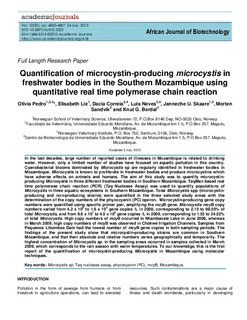| dc.contributor.author | Pedro, Olivia | |
| dc.contributor.author | Lie, Elisabeth | |
| dc.contributor.author | Correia, Dacia | |
| dc.contributor.author | Neves, Luis C. | |
| dc.contributor.author | Skåre, Janneche Utne | |
| dc.contributor.author | Sandvik, Morten | |
| dc.contributor.author | Berdal, Knut G | |
| dc.date.accessioned | 2017-09-20T11:34:07Z | |
| dc.date.available | 2017-09-20T11:34:07Z | |
| dc.date.created | 2016-06-29T13:05:10Z | |
| dc.date.issued | 2013 | |
| dc.identifier.citation | African Journal of Biotechnology. 2013, 12 (30), 4850-4857. | nb_NO |
| dc.identifier.issn | 1684-5315 | |
| dc.identifier.uri | http://hdl.handle.net/11250/2455776 | |
| dc.description.abstract | In the last decades, large number of reported cases of illnesses in Mozambique is related to drinking water. However, only a limited number of studies have focused on aquatic pollution in this country. Cyanobacterial blooms dominated by Microcystis sp are regularly identified in freshwater bodies in Mozambique. Microcystis is known to proliferate in freshwater bodies and produce microcystins which have adverse effects on animals and humans. The aim of this study was to quantify microcystin-producingMicrocystis in three different freshwater bodies in Southern Mozambique. TaqMan based real time polymerase chain reaction (PCR) (Taq Nuclease Assay) was used to quantify populations of Microcystis in three aquatic ecosystems in Southern Mozambique. Total Microcystis spp (microcystin-producing and non-producing strains) were quantified in the three selected study areas with the determination of the copy numbers of the phycocyanin (PC) operon. Microcystin-producing gene copy numbers were quantified using specific primer pair, amplifying the mcyB gene.Microcystis mcyB copy numbers varied from 4.2 x 106 to 1.6 x 109 gene copies /L in 2008, corresponding to 2.15 to 98.55% of total Microcystis, and from 9.6 x 107 to 4.5 x 109 gene copies /L in 2009, corresponding to 1.53 to 34.52% of total Microcystis. High copy numbers of mcyB occurred in Nhambavale Lake in June 2008, whereas in March 2009, high copy numbers of mcyB was observed in Chòkwé Irrigation Channels. Samples from Pequenos Libombos Dam had the lowest number of mcyB gene copies in both sampling periods. The findings of the present study show that microcystin-producing strains are common in Southern Mozambique, and that their absolute and relative numbers varies geographically and temporarily. The highest concentration of Microcystis sp. in the sampling areas occurred in samples collected in March 2009, which corresponds to the rain season with warm temperatures. To our knowledge, this is the first report of the quantification of microcystin-producingMicrocystis in Mozambique using molecular techniques. | nb_NO |
| dc.language.iso | eng | nb_NO |
| dc.relation.uri | http://academicjournals.org/journal/AJB/article-abstract/8292B3630559 | |
| dc.rights | Attribution-NonCommercial-NoDerivatives 4.0 Internasjonal | * |
| dc.rights.uri | http://creativecommons.org/licenses/by-nc-nd/4.0/deed.no | * |
| dc.title | Quantification of microcystin-producing microcystis in freshwater bodies in the Southern Mozambique using quantitative real time polymerase chain reaction. | nb_NO |
| dc.type | Journal article | nb_NO |
| dc.type | Peer reviewed | nb_NO |
| dc.description.version | publishedVersion | nb_NO |
| dc.source.pagenumber | 4850-4857 | nb_NO |
| dc.source.volume | 12 | nb_NO |
| dc.source.journal | African Journal of Biotechnology | nb_NO |
| dc.source.issue | 30 | nb_NO |
| dc.identifier.doi | 10.5897/AJB12.2023 | |
| dc.identifier.cristin | 1364962 | |
| dc.relation.project | Norges forskningsråd: 196085 | nb_NO |
| cristin.unitcode | 192,16,2,0 | |
| cristin.unitname | Institutt for mattrygghet og infeksjonsbiologi | |
| cristin.ispublished | true | |
| cristin.fulltext | original | |
| cristin.qualitycode | 0 | |

